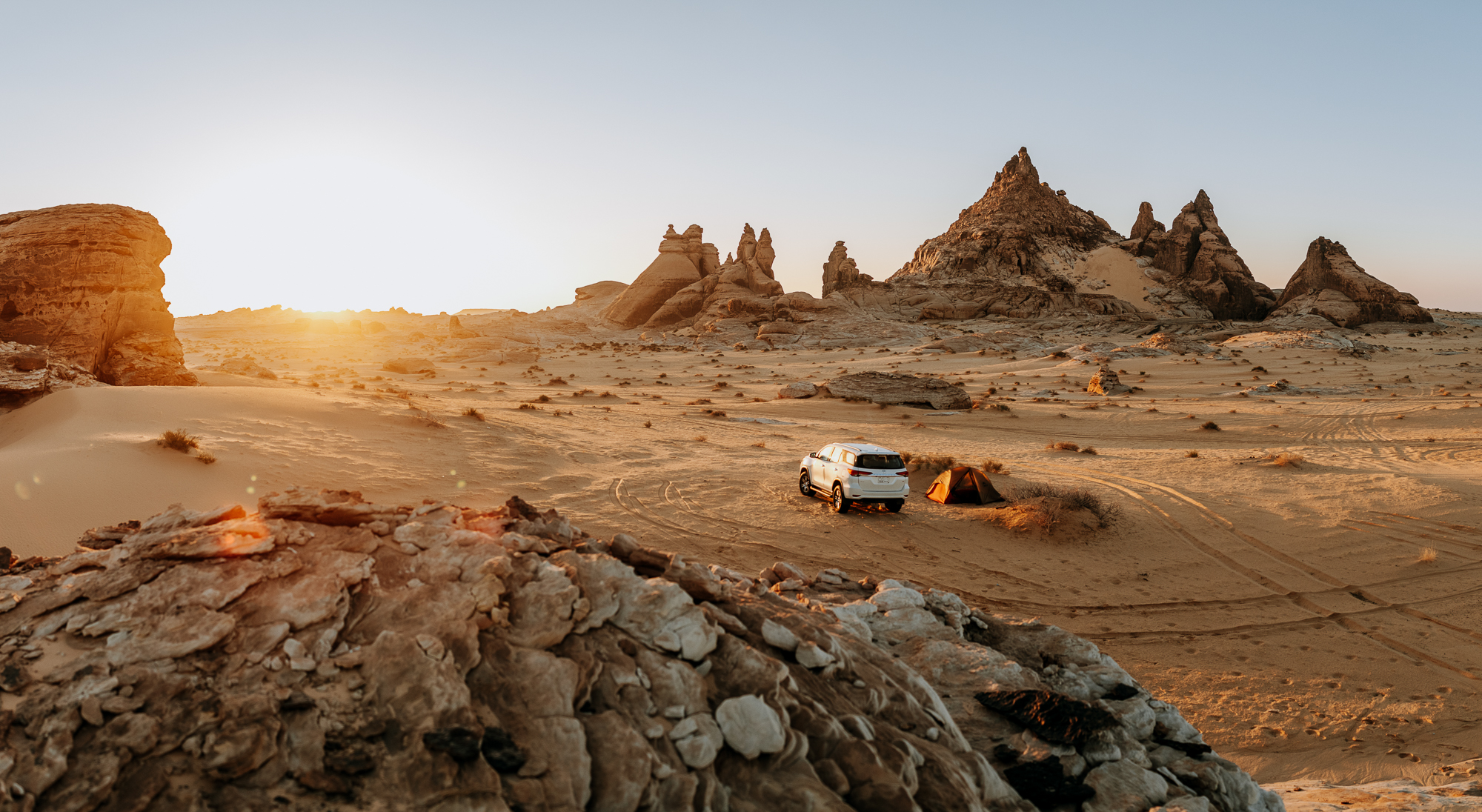Editor’s Note: This article was originally published in Overland Journal’s Summer 2022 Issue.
Over the years, I have found myself stepping into rented or borrowed vehicles for a myriad of trips. These adventures include flying into a destination, borrowing a vehicle, and dry camping for multiple days. Last year I chased the Baja 1000 and needed my camping gear for a week of prerunning, all while driving someone else’s truck. Most recently, I flew to Saudi Arabia, rented a Toyota Fortuner, and explored the country for three weeks. This fly-and-drive kit accompanies me each time, allowing me to camp comfortably, safely, and self-sustained.
Essentially, this is my backpacking kit modified for overlanding and packed into a duffel bag. Many destinations or journeys will require specific pieces of gear, but this is my baseline for most trips. I also bring my photography equipment (stored in my trusty dust and waterproof Pelican Air 1535, a carry-on friendly case) and a backpack of clothing on every adventure.
Visualize the details of your trip: Where are you going? What is the climate? What activities are you doing? What are you driving? In what conditions are you sleeping? Use this information and the list below to come up with your own amalgamation. Over time, you’ll gain more experience and implement revisions, but this will help create a good starting point.
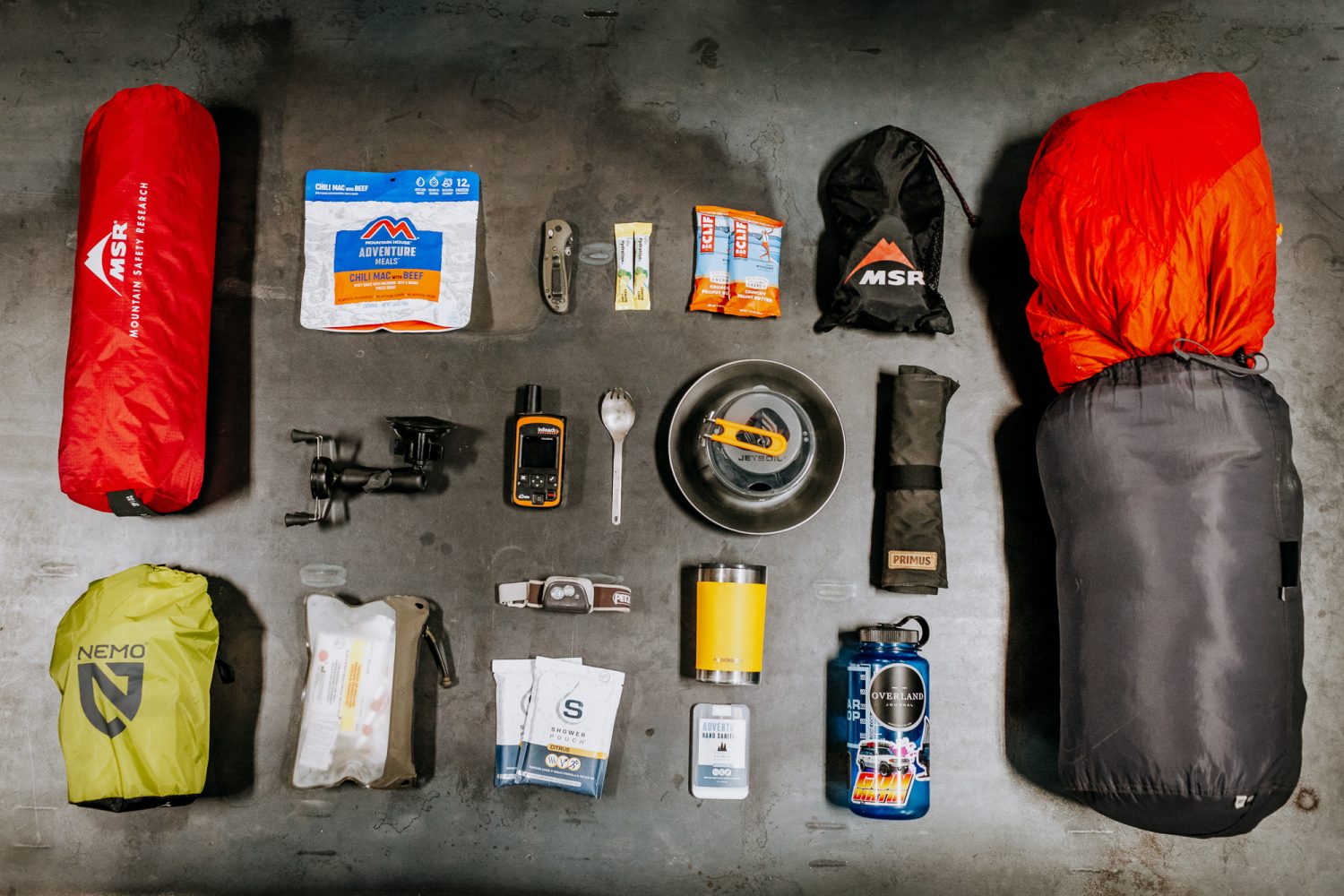
DUFFEL BAG (the Foundation)
There are a variety of options to contain all of my equipment. Suitcases, backpacks, or daypacks all work well, but I like to stick with the classic duffel bag. Soft sides reduce wear and tear on any vehicle, and the bag itself is usually fairly light. Use one that’s dust- and water-resistant (waterproof is even better). There are plenty of times when the bag will be thrown in the back of a pickup, strapped to the roof of an SUV, or left out in the weather at a campsite. Trusting that the valuable gear you’re storing inside is protected is well worth the price of admission. When the duffel gets covered in silt, all you need to do is wipe it down with a wet cloth to clean it. I find a 90-liter bag works well for one person, but you can fit enough gear in it for two if you bring the most efficiently sized tent, sleeping bags, and sleeping pads.
I’m currently using the Front Runner Typhoon. The IP66 rating (guaranteeing an airtight seal) and simple roll-top make it easy to load and protect gear from the elements. Others, like the Patagonia Black Hole, The North Face Base Camp, or Halite Kraken are great options depending on your budget, size, and protection requirements. Beware of bags that don’t seal well—you’ll eventually find sand, silt, or water amongst your precious equipment.
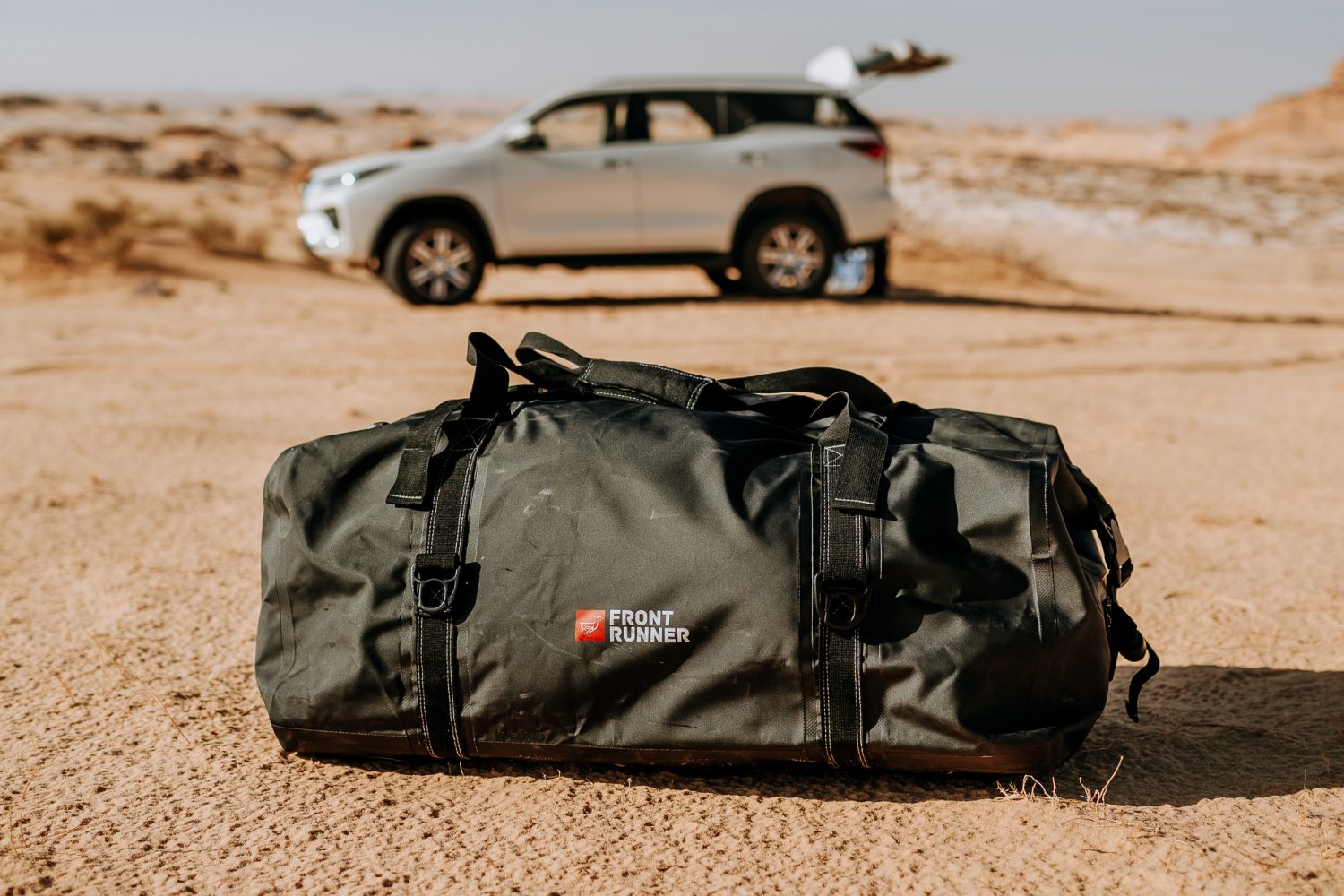
TENT
My choice for a tent aligns with what I’d choose for backpacking while considering the seasons I’ll be traveling in—normally a three-season model. The smaller and lighter it is, the less room it takes up, and the more your shoulder will appreciate it when lugging the duffel bag through airports. Don’t forget that the more slight the tent, the more expensive it will be. Find a tent acceptable for your style of travel that fits within your budget.
My go-to tent is an MSR Freelite 2. It’s easy to set up after a long day of working or traveling, all while remaining very lightweight and small when packed. An MSR Hubba Hubba 3 is my preferred option if more space is required in the tent.
SLEEPING PAD
A pad that’s light, packs down small, and is comfortable is key. Choose one with a pump or other means of inflating it without the need to blow into it to keep moisture (and eventually mold) out. Plus, it’ll save you from becoming lightheaded at 10,000 feet elevation.
My Nemo Astro insulated sleeping pad isn’t the smallest or lightest option, but it’s a little more comfortable than backpacking offerings. The Primaloft synthetic insulation helps to create a thermal barrier between me and the cold ground. If I really need to save space, I’ll use a Nemo Tensor, but more often than not, I’ll sacrifice a bit of room and weight for a better sleep experience.
SLEEPING BAG
I’d rather be too warm than too cold. For all but the coldest environments, my Marmot Never Summer -18°C down-filled sleeping bag does the trick and has done so for the last eight years. I’ve used it with success in every season throughout North America and Latin America. It’s not quite warm enough for the Canadian winters, but it does the job perfectly the rest of the time.

COOKWARE
The goal here is not to bring enough gear to cook an elaborate meal but to have the basics that are used most frequently. Utensils, a reusable coffee mug, stainless steel bowl, and knife are more than enough to help meet my nutritional needs and wants.
My current setup includes the following
- Kovea stainless steel plate
- Snowpeak spork
- Dometic 11-ounce insulated tumbler
- Primus CampFire prep set
- Benchmade Griptilian knife
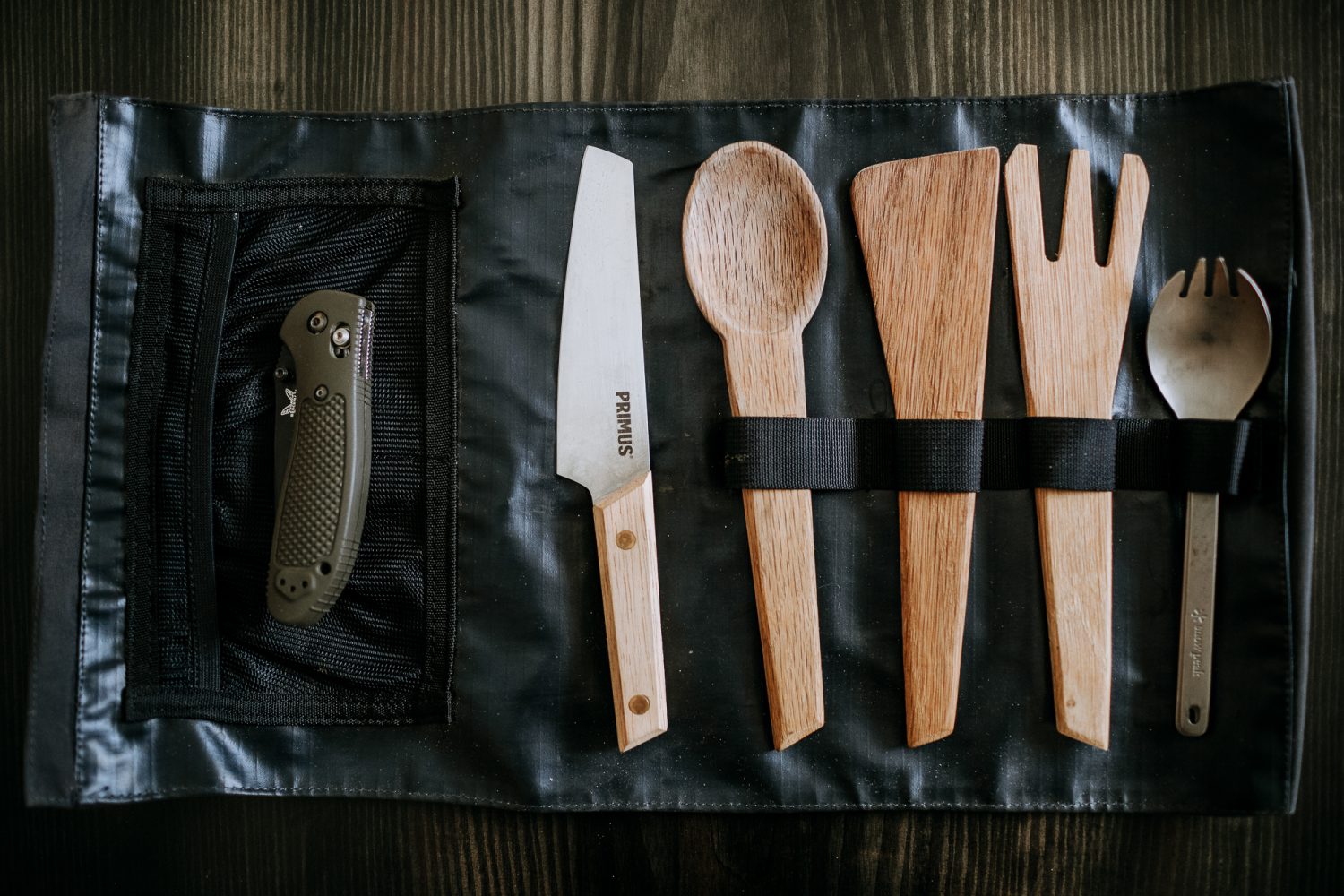

FOOD
My mindset quickly changes when I get hungry, and not in a good way. To fight hunger on the run, I keep a handful of Clif bars close by, even if they’re just enough to get me through the airport. Mountain House meals make a perfect emergency lunch or dinner when on the road if you don’t have other options or if you’re just in love with their Breakfast Skillet or Chili Mac with Beef. If coffee isn’t available (blasphemy!), I can be my own barista with a Starbucks VIA or two until I find the best local coffee option. Add a couple of electrolyte packs to fend off dehydration in hot environments.
WATER
Having an appropriate container is paramount. My 1-liter Nalgene is well-used, well-stickered, and a classic vessel for storing and drinking water; it’s lightweight when empty and BPA free. Bringing a water filter for suspect drinking water is a smart move. A LifeStraw Personal water filter is a great emergency option that doesn’t take up too much space, but if there is room, I’ll throw my MSR MiniWorks EX into the duffel for water filtering duties.
STOVE
A Jetboil Flash has been my go-to backpacking stove for years, but lately, I’ve been using the smaller Stash model to reduce size and weight. It works perfectly for boiling water no matter what you end up using that water for—coffee in the morning, dehydrated meals in the afternoon, or boiling water for that Nalgene if I need to stay warm in the sleeping bag during especially frigid winter nights. Don’t forget to confirm that isobutane or propane canisters (or whatever your required fuel is) can be found at your destination.
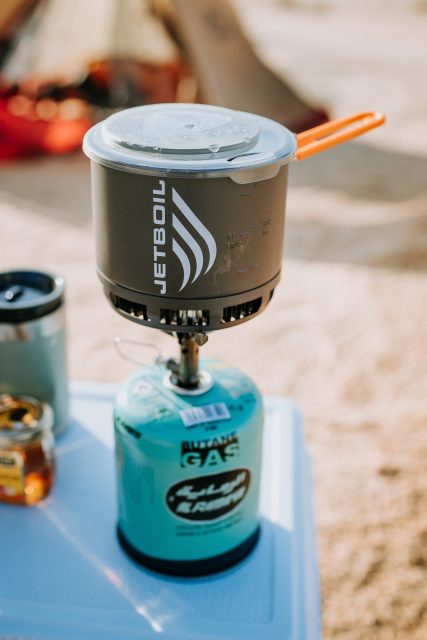
HYGIENE
A shower or a place to wash my hands isn’t always available. Instead of risking a week or two of offending others or picking up some unwanted virus, I always bring a few ShowerPouch oversized wet wipes and a bottle of hand sanitizer. A little bit of toilet paper in a Ziploc bag can go a long way if you have emergency business in the wilderness. Sea to Summit Wilderness Wash is a concentrated, biodegradable soap suitable for hands, dishes, or laundry.
HEADLAMP
You’re going to find yourself in the dark at some point of any trip (far north summer adventures notwithstanding). My Petzel Tikka XP continues to be my favorite headlamp, especially with its rechargeable AAA batteries. More companies are offering rechargeable options; make sure you have a battery pack or proper USB outlet in the vehicle for charging.
COMMUNICATION
Even if I plan ahead and buy a SIM card for the country I’m visiting, there’s no guarantee that it will work after arrival or throughout the country. Because of that, a Garmin (previously DeLorme) InReach always remains close at hand, providing the ability to communicate with friends, family, co-workers, or in the worst-case scenario, emergency workers, regardless of where I am in the world.
BATTERY PACK
Communication devices, rechargeable headlamps, or trusty iPhones don’t work without power, so I like to bring a small battery pack to charge USB-powered devices just in case. Anker makes quality products that are readily available on Amazon.

CELL PHONE CAR MOUNT
One of my favorite accessories in my personal vehicle is a Ram X-Grip phone mount with a Twist-Lock suction cup. We’ve all tried to navigate with our phones precariously perched on the dash of a car. It’s not safe and doesn’t work. No matter how much I try, the phone tends to fly across the dashboard at some point or another. While on a vehicle-based adventure, I always bring a Ram universal holder to securely mount the phone and keep two hands on the wheel.
FIRST AID KIT
Don’t forget to take a basic first aid kit, especially with any medication you know you’ll need. I know that my ability to function well drops significantly if I have a throbbing headache, so a few extra Vitamin Is (ibuprofen) are stashed away just in case. I use a small custom kit contained in a small Magpul DAKA Pouch, but an easier method is to pick up a complete one from Adventure Medical Kits. Don’t forget to complete a (Wilderness) First Aid course, so you know how to use the contents properly.
Our No Compromise Clause: We carefully screen all contributors to ensure they are independent and impartial. We never have and never will accept advertorial, and we do not allow advertising to influence our product or destination reviews.
Read more: Patagonia Performance Twill Jeans


